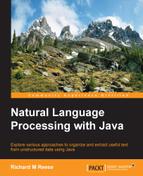Natural Language Processing (NLP) has been used to address a wide range of problems, including support for search engines, summarizing and classifying text for web pages, and incorporating machine learning technologies to solve problems such as speech recognition and query analysis. It has found use wherever documents contain useful information.
NLP is used to enhance the utility and power of applications. It does so by making user input easier and converting text to more usable forms. In essence, NLP processes natural text found in a variety of sources, using a series of core NLP tasks to transform or extract information from the text.
This book focuses on core NLP tasks that will likely be encountered in an NLP application. Each NLP task presented in this book starts with a description of the problem and where it can be used. The issues that make each task difficult are introduced so that you can understand the problem in a better way. This is followed by the use of numerous Java techniques and APIs to support an NLP task.
Chapter 1, Introduction to NLP, explains the importance and uses of NLP. The NLP techniques used in this chapter are explained with simple examples illustrating their use.
Chapter 2, Finding Parts of Text, focuses primarily on tokenization. This is the first step in more advanced NLP tasks. Both core Java and Java NLP tokenization APIs are illustrated.
Chapter 3, Finding Sentences, proves that sentence boundary disambiguation is an important NLP task. This step is a precursor for many other downstream NLP tasks where text elements should not be split across sentence boundaries. This includes ensuring that all phrases are in one sentence and supporting parts of speech analysis.
Chapter 4, Finding People and Things, covers what is commonly referred to as Named Entity Recognition. This task is concerned with identifying people, places, and similar entities in text. This technique is a preliminary step for processing queries and searches.
Chapter 5, Detecting Parts of Speech, shows you how to detect parts of speech, which are grammatical elements of text, such as nouns and verbs. Identifying these elements is a significant step in determining the meaning of text and detecting relationships within text.
Chapter 6, Classifying Texts and Documents, proves that classifying text is useful for tasks such as spam detection and sentiment analysis. The NLP techniques that support this process are investigated and illustrated.
Chapter 7, Using Parser to Extract Relationships, demonstrates parse trees. A parse tree is used for many purposes, including information extraction. It holds information regarding the relationships between these elements. An example implementing a simple query is presented to illustrate this process.
Chapter 8, Combined Approaches, contains techniques for extracting data from various types of documents, such as PDF and Word files. This is followed by an examination of how the previous NLP techniques can be combined into a pipeline to solve larger problems.
